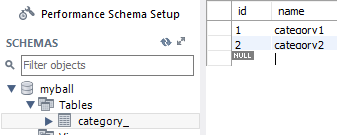使用 Mybatis 简化 JDBC 操作

在 Java简明笔记(十三)JDBC 中,使用 JDBC 来操作数据库,并把查询到的数据库信息进行 java 对象的映射(ORM),但是 JDBC 除了需要自己写SQL之外,还必须操作Connection, Statment, ResultSet,显得繁琐和枯燥。于是我们对 JDBC 进行封装,以简化数据库操作。mybatis就是这样的一个框架。
以下简介摘自官方文档:
MyBatis是一款优秀的持久层框架,它支持定制化 SQL、存储过程以及高级映射。MyBatis 避免了几乎所有的 JDBC 代码和手动设置参数以及获取结果集。MyBatis 可以使用简单的 XML 或注解来配置和映射原生信息,将接口和 Java 的 POJOs(Plain Old Java Objects,普通的 Java对象)映射成数据库中的记录。
IDEA 实战
创建数据库和表
使用 MYSQL :
- 创建数据库,库名: myball
- 创建表,表名:category_
- 表分为 id 列 和 name 列, name 列填充category1 和 category2

新建工程
使用 IDEA 新建一个 maven 工程,在 pom.xml 中写入依赖
pom.xml
<dependencies>
<dependency>
<groupId>org.mybatis</groupId>
<artifactId>mybatis</artifactId>
<version>3.4.6</version>
</dependency>
<!-- https://mvnrepository.com/artifact/mysql/mysql-connector-java -->
<dependency>
<groupId>mysql</groupId>
<artifactId>mysql-connector-java</artifactId>
<version>8.0.9-rc</version>
</dependency>
</dependencies>准备实体类 Category
这个类用来映射数据库信息为java对象(数据库 category_ 表 -> java 的 category对象)
注意:java对象要和数据库信息对应上。比如表category_有 id 和 name,对象category就要有 int id 和 String name。
src/main/java/com.jerrysheh.pojo/Category.java
public class Category {
private Long id;
private String name;
// 省略 getter setter
}创建配置文件 mybatis-config.xml
在 src/main/java 目录下 创建 mybatis-config.xml,填入以下内容: (SpringBoot 免此配置)
<?xml version="1.0" encoding="UTF-8" ?>
<!DOCTYPE configuration
PUBLIC "-//mybatis.org//DTD Config 3.0//EN"
"http://mybatis.org/dtd/mybatis-3-config.dtd">
<configuration>
<typeAliases>
<package name="com.jerrysheh.pojo"/>
</typeAliases>
<environments default="development">
<environment id="development">
<transactionManager type="JDBC"/>
<dataSource type="POOLED">
<property name="driver" value="com.mysql.cj.jdbc.Driver"/>
<property name="url" value="jdbc:mysql://localhost:3306/myball?characterEncoding=UTF-8&serverTimezone=GMT%2B8&useSSL=false"/>
<property name="username" value="root"/>
<property name="password" value="123456"/>
</dataSource>
</environment>
</environments>
<mappers>
<mapper resource="com/jerrysheh/pojo/Category.xml"/>
</mappers>
</configuration><dataSource>主要提供连接数据库用的驱动,数据库名称,编码方式,账号密码以及别名<typeAliases>写明包后,就会自动扫描这个包下面的类型<mappers>是映射
创建配置文件 Category.xml
在包 com.jerrysheh.pojo 下创建 Category.xml
<?xml version="1.0" encoding="UTF-8"?>
<!DOCTYPE mapper
PUBLIC "-//mybatis.org//DTD Mapper 3.0//EN"
"http://mybatis.org/dtd/mybatis-3-mapper.dtd">
<mapper namespace="com.jerrysheh.pojo">
<select id="listCategory" resultType="Category">
select * from category_
</select>
</mapper>namespace指明哪个包resultType指映射出来的java对象类型,因为在上一个配置文件已经在<typeAliases>写明包名,所以这里不用给出全名(com.jerrysheh.pojo.Category)
测试类 Test
Test.java
public class Test {
public static void main(String[] args) throws IOException {
String resource = "mybatis-config.xml";
InputStream inputStream = Resources.getResourceAsStream(resource);
SqlSessionFactory sqlSessionFactory = new SqlSessionFactoryBuilder().build(inputStream);
SqlSession session = sqlSessionFactory.openSession();
List<Category> cs = session.selectList("listCategory");
for (Category c : cs) {
System.out.println(c.getName());
}
}
}事实上,Mybatis 做了以下几件事:
- 应用程序找 Mybatis 要数据
- Mybatis从数据库中找来数据(通过 mybatis-config.xml 定位哪个数据库,通过 Category.xml 执行对应的select语句)
- 基于 Category.xml 把返回的数据库记录封装在 Category 对象中
- 把多个 Category 对象装在一个 Category 集合中
- 返回一个 Category 对象的集合
使用 mybatis 增删查改
修改 Category.xml 文件,添加增删查改的SQL语句。
<?xml version="1.0" encoding="UTF-8"?>
<!DOCTYPE mapper
PUBLIC "-//mybatis.org//DTD Mapper 3.0//EN"
"http://mybatis.org/dtd/mybatis-3-mapper.dtd">
<mapper namespace="com.jerrysheh.pojo">
<insert id="addCategory" parameterType="Category" >
insert into category_ ( name ) values (#{name})
</insert>
<delete id="deleteCategory" parameterType="Category" >
delete from category_ where id= #{id}
</delete>
<select id="getCategory" parameterType="_int" resultType="Category">
select * from category_ where id= #{id}
</select>
<update id="updateCategory" parameterType="Category" >
update category_ set name=#{name} where id=#{id}
</update>
<select id="listCategory" resultType="Category">
select * from category_
</select>
</mapper>增
在测试类Test中通过session将对象映射为数据库信息,插入表
// 这四句是固定写法
String resource = "mybatis-config.xml";
InputStream inputStream = Resources.getResourceAsStream(resource);
SqlSessionFactory sqlSessionFactory = new SqlSessionFactoryBuilder().build(inputStream);
SqlSession session = sqlSessionFactory.openSession();
// 实例化一个Category对象
Category c = new Category();
c.setName("category3");
//通过session,将该对象映射为数据库信息,插入到表中
//第一个参数是 Category.xml 中的 id
session.insert("addCategory",c);删
删除 id 号为 2 的category
// 实例化一个Category对象
Category c = new Category();
c.setId(2);
//通过session,将该对象映射为数据库信息,从表中删除
session.delete("deleteCategory", c);改
// 通过session.selectOne取出一个Category对象
// 第二个参数是 Category.xml 的 getCategory 行的 parameterType,这里对应 int ,也就是 id 号
Category c= session.selectOne("getCategory",3);
//修改对象
c.setName("修改了的Category名稱");
//通过session,将该对象映射为数据库信息,从表中更新
session.update("updateCategory",c);查
listAll(session);
// 提交和关闭 session
session.commit();
session.close();
private static void listAll(SqlSession session) {
List<Category> cs = session.selectList("listCategory");
for (Category c : cs) {
System.out.println(c.getName());
}
}模糊查询
在 Category.xml 中添加模糊查询语句:
<select id="listCategoryByName" parameterType="string" resultType="Category">
select * from category_ where name like concat('%',#{0},'%')
</select>concat是一个 SQL 函数,表示字符串连接。在这个例子中,concat('%',#{0},'%') 表示 [零个或多个字符] + 参数{0} + [零个或多个字符], 比如参数{0}是 cat,可以匹配 hellocatWTF
在 测试类 Test.java 中
listbyName(session,"gory");
private static void listbyName(SqlSession session, String param) {
List<Category> cs = session.selectList("listCategoryByName", param);
for (Category c : cs) {
System.out.println(c.getName());
}
}session.selectList()提供第二个参数,这个参数就是Category.xml 中的 param#{0}
多条件查询
在 Category.xml 中添加多条件查询语句:
查询 id 号大于某个参数的
<select id="listCategoryByIdAndName" parameterType="map" resultType="Category">
select * from category_ where id> #{id} and name like concat('%',#{name},'%')
</select>因为是多个参数,而selectList方法又只接受一个参数对象,所以需要把多个参数放在Map里,然后把这个Map对象作为参数传递进去
Map<String,Object> params = new HashMap<>();
// id号大于 4 的
params.put("id", 4);
// name 包含 cat的
params.put("name", "cat");
listbyIdAndName(session,params);
private static void listbyIdAndName(SqlSession session, Map<String,Object> param) {
List<Category> cs = session.selectList("listCategoryByIdAndName", param);
for (Category c : cs) {
System.out.println(c.getName());
}
}动态SQL
if
我们前面提供了 listCategory 全部查询 和 listCategoryByName 模糊查询 两种方式。要写两个 SQL 语句。可以看到 session.selectList() 既能接受一个参数,也能接受两个参数。
那么可不可以,只写一个 SQL 语句, 当session.selectList()只有一个参数的时候,进行全部查询,提供第二个参数的时候,提供模糊查询呢?答案是肯定的。
假如我们要查询的表是 Product_ 表,对应的java对象类为 Product 类。
Product.xml 修改前:
<?xml version="1.0" encoding="UTF-8"?>
<!DOCTYPE mapper
PUBLIC "-//mybatis.org//DTD Mapper 3.0//EN"
"http://mybatis.org/dtd/mybatis-3-mapper.dtd">
<mapper namespace="com.how2java.pojo">
<select id="listProduct" resultType="Product">
select * from product_
</select>
<select id="listProductByName" resultType="Product">
select * from product_ where name like concat('%',#{name},'%')
</select>
</mapper>Product.xml 修改后:
<?xml version="1.0" encoding="UTF-8"?>
<!DOCTYPE mapper
PUBLIC "-//mybatis.org//DTD Mapper 3.0//EN"
"http://mybatis.org/dtd/mybatis-3-mapper.dtd">
<mapper namespace="com.how2java.pojo">
<select id="listProduct" resultType="Product">
select * from product_
<if test="name!=null">
where name like concat('%',#{name},'%')
</if>
</select>
</mapper>其他动态SQL语句
除了 if 以外,还有 where、choose、foreach、bind等动态SQL语句,具体用法可以到网上查找。
